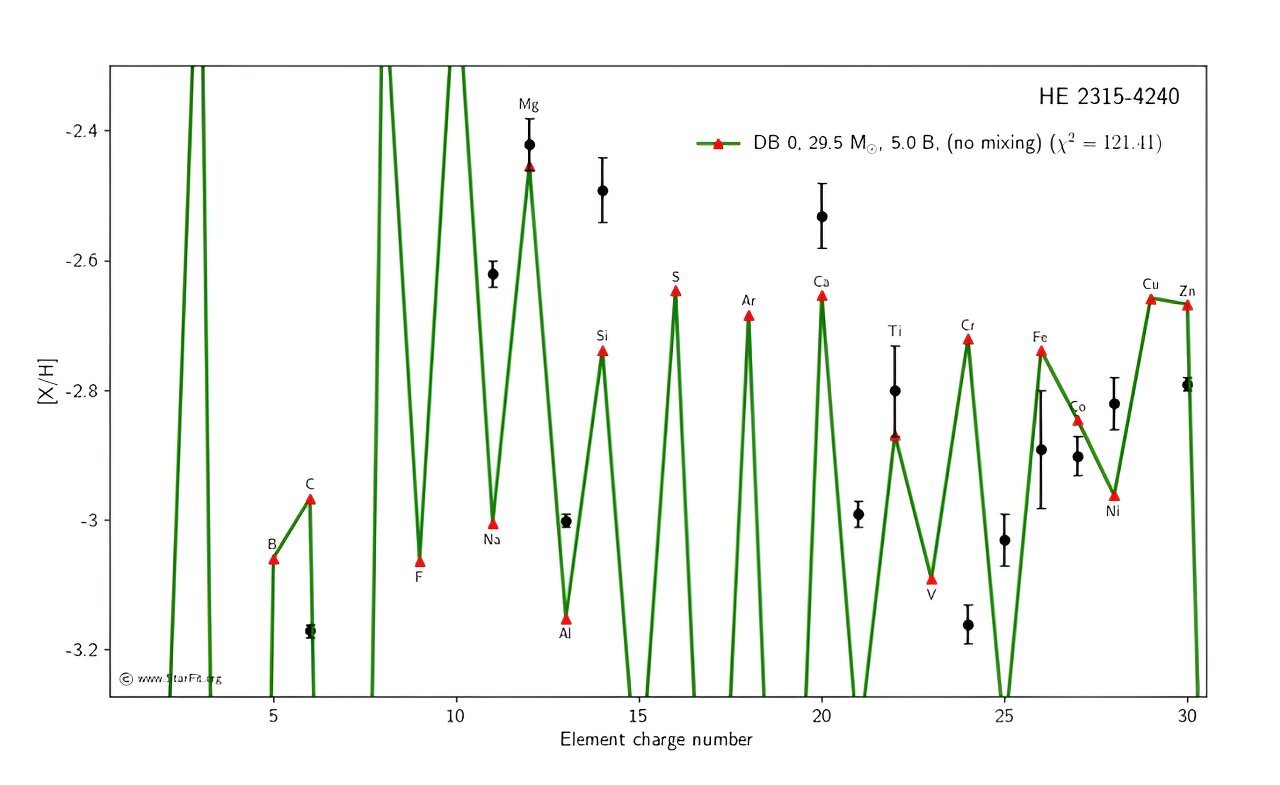Abundance ratio [X/H] of HE 2315−4240 (black filled circles) as a function of atomic number. Overplotted in green is the best-matched Population III nucleosynthesis model. The mass and energy of the model are shown in the upper right. Credit: Wang et al., 2024.
Based on data from the Magellan-Clay telescope in Chile, astronomers have performed a chemodynamic study of a very metal-poor star known as HE 2315−4240. The results of the study, published on the preprint server arXivprovides important insight into the nature of this star.
Metal-poor stars are rare objects, with only a few thousand iron-abundant stars [Fe/H] below -2.0 have been detected to date. Expanding the still short list of metal-poor stars is of great importance to astronomers, as such objects have the potential to improve our knowledge of the universe’s chemical evolution.
With a metallicity of approximately −2.89 dex, HE 2315−4240 is a very metal-poor star at an estimated distance of about 9,300 light-years from Earth. Given that the star is poorly studied and very little is known about its properties, a team of astronomers led by Xinuo Wang of Cornell University in Ithaca, New York, decided to study it with the Magellan Inamori Kyocera Echelle (MIKE) spectrograph mounted on the Magellan -Clay telescope.
“In this study, we present a spectrum of a very metal-poor star, HE 2315−4240, with [Fe/H] = −2.89 based on a Magellan/MIKE high-resolution visual light spectrum,” the study states.
In all, Wang’s team managed to derive abundances of 19 elements. The alpha and iron peak elements were found to agree well with the abundance trend of other known metal-poor stars. According to the astronomers, this confirms that at least one supernova enhanced these elements in the gas cloud that formed HE 2315−4240.
Furthermore, the observations found that HE 2315−4240 has low strontium-to-barium and carbon-to-iron abundance ratios. These results indicate that the star is accreted and formed in a dwarf galaxy. The effective temperature of HE 2315−4240 was estimated to be 5,181 K, making it a hot giant.
According to the study, the metallicity of HE 2315−4240, along with its abundance of magnesium and silicon, suggests that the star formed from the gas enriched by a type II supernova explosion. The astronomers assume that the progenitor was most likely a massive (about 10 solar masses) Population III star. The hypothetical Population III stars, composed almost entirely of primordial gas, are theorized to be the first stars to form after the Big Bang.
Based on the kinematic analysis performed, the researchers assume that HE 2315−4240 formed outside the galactic disc, probably in a small dwarf galaxy, and was later absorbed by the growing Milky Way.
“The Progenitor system likely formed before other systems, placing the star in the inner halo as we know it today,” the paper concluded.
More information:
Xinuo Wang, Chemodynamic abundance analysis of the very metal-poor halo star HE 2315-4240, arXiv (2024). DOI: 10.48550/arxiv.2410.02586
Log information:
arXiv
© 2024 Science X Network
Quote: Study probes very metal-poor star HE 2315−4240 (2024, October 13) Retrieved October 13, 2024, from https://phys.org/news/2024-10-metal-poor-star.html
This document is subject to copyright. Except for any fair dealing for the purpose of private study or research, no part may be reproduced without written permission. The content is provided for informational purposes only.
